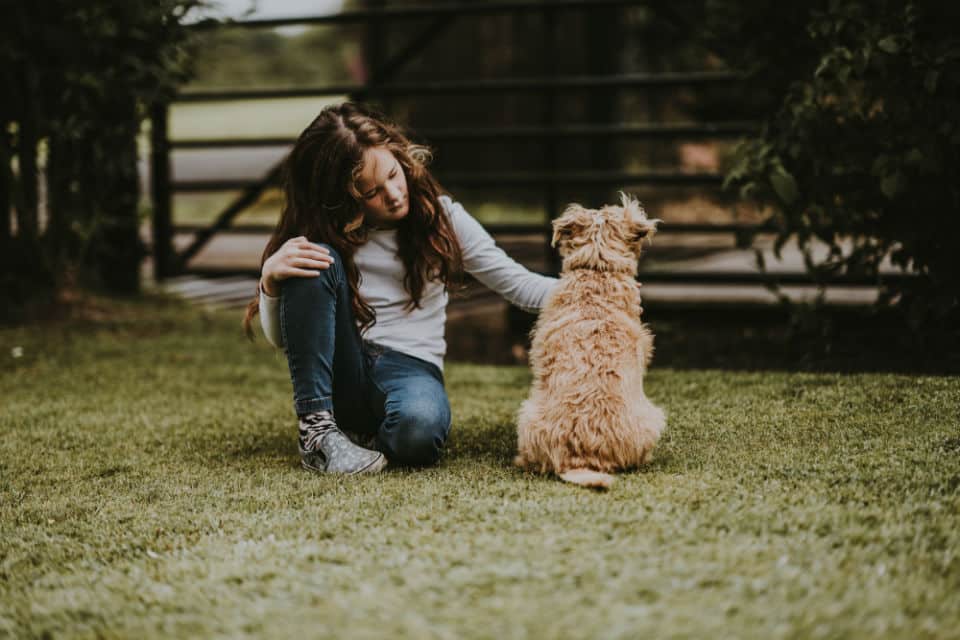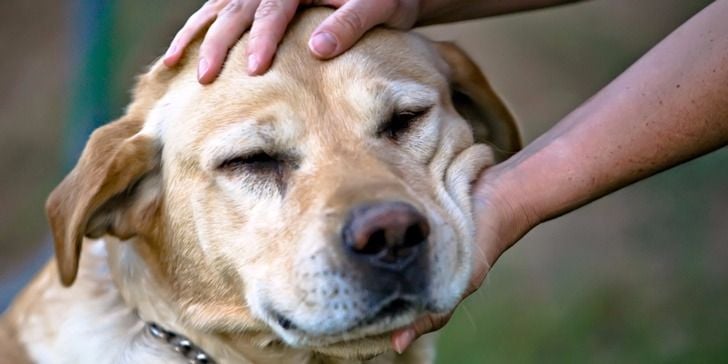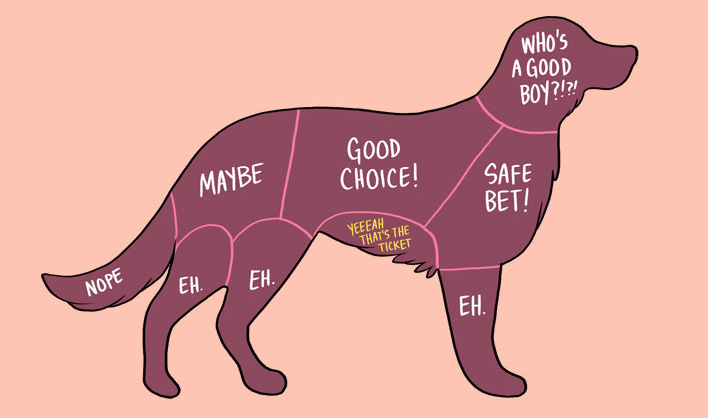Patting a dog—it seems so simple! And of course, there are many ways to stroke a dog, depending on your dog’s preference and your own routines. This fun video demonstrates just how true that is.
 
That said, the wrong sort of patting can make dogs dog nervous or scared—even if that’s the last thing we intend. Some dog lovers aren’t sure how to read a dog’s body language, so they mistake fear for friendliness. And even if it’s a dog you know and love, you might be doing something they don’t prefer.
In this article, dog behaviourist Beverly Ulbrich guides us through the basics to approaching and patting dogs, whether it be a stray or your best friend’s furry pal.
Patting an Unknown or Stray Dog

When meeting a dog for the first time, reach your hand out gently and let the dog come to you. Photo courtesy of The Pooch Coach, Beverly Ulbrich.
When you see a dog you don’t know, it’s important not to spook him as you approach.
“A mistake people make when there is a stray is to run after them to try to catch them,” Ulbrich says. “Almost any dog would run away from that. Even the nicest, most well-trained dog is going to be on edge and panicking because they are lost or in a strange place, so realise how scared they are.”
Be as non-threatening as possible, which means crouching down and even turning your body sideways. The main thing is not to stand and bend over the dog.
“If the dog sees you as bending over them, that is taken as dominance,” Ulbrich says. “If a dog does that to another dog—posturing over the other dog—the next move is humping. The dog could see bending over him as a threat and get scared.”
Once you are squatting down, extend your hand and let the dog come to you. If the dog comes forward wagging his tail, you can pat him. If he stands there, backs off, or pulls his head away, it’s best to leave him alone.
“It’s like between people. If you’re reaching for a handshake and the other person reaches back, you meet midway. You never grab the person’s hand from their side.”
Pay attention to the dog’s body language, too. If his tail is stiff or tightly tucked, he’s uncomfortable.
You can’t always trust a wagging tail, either—if the hair is raised on the centre of his back or his ears are pinned back and there is still some tail wagging, the dog is likely nervous and you should proceed with caution.
Meeting a Friendly Dog
When you’re meeting a dog for the first time, whether it be a friend’s dog or a dog in the park, follow the same non-threatening protocol as with a stray.
Squat down, extend your hand, and let the dog come to you. You should also be relaxed.

Unsplash/Annie Spratt
“Make sure your body language is laid back and you are gently reaching out your hand, not overcoming the dog,” Ulbrich advises. “And because it is a new dog to you, still ask if the dog is friendly and ask if they have a favourite spot to be pat.”
You can also have treats handy, which usually helps! Another tactic is asking the dog to sit.
“Once dogs hear that command, a lot of them will automatically do it,” Ulbrich explains. “It also gives you insight as to whether they are trained or not.”
Patting Your Dog Buddies
A dog you know and love should be happy to see you and comfortable with you patting him. Still, there are some rules to keep in mind.
The first thing is to know and follow the pet parent’s rules. For example, perhaps the dog needs to sit before you pat him, or the pet parent might prefer you never pat him while he’s jumping on you.
“You may be reinforcing bad or potentially harmful behaviour,” Ulbrich explains. “Not only is it impolite to jump up on people, but if your dog jumps on someone who is scared or unsuspecting, it can knock them over or cause them to trip.”
Kids can get rough with dogs, which they may not particularly enjoy. Whether it’s pulling on their ears, big hugs, or even jumping on their backs, some dogs are fine with it while others are not.
If it’s a dog you know and love, you or his owner should know where to draw the line but keep the dog’s personal space in mind.
The Importance of Patting
Dr. Stanley Coren, Professor Emeritus of Psychology at the University of British Columbia, explains that an interesting study proved that just seeing you will get a dog excited, but patting makes the dog happiest.
“Where there was no social interaction [in the study], the dogs actually seemed bothered,” Dr. Coren writes. “It is the sensation of being touched by that person which helps to boost the level of good feeling in the dog.”
It helps if you know a dog’s sweet spot—the spot that makes his leg kick with joy! With a familiar dog, this should be easy to figure out, or you could simply refer to this handy chart:
The Bottom Line
Patting a dog shouldn’t be stressful for either of you. In fact, studies show that talking to and stroking a dog lowers blood pressure! So indulge in plenty of it. Just be sure to read the dog’s body language, and take extra precautions if the dog is unfamiliar to you.





